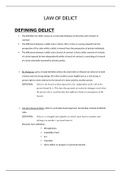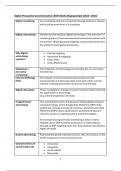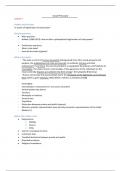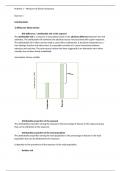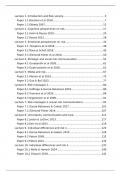Lecture 1: Chapter 1
1. Understanding consumer behaviour
1.1 Defining consumer behaviour
Consumer behaviour reflects the totality of consumer’s decisions with respect to the acquisition,
consumption, and disposition of goods, services, activities, experiences, people, and ideas by
(human) decision-making units (over time).
Offering: a product, service, activity, experience, or idea offered by a marketing organization to
consumers.
Marketers are intensely interested in consumer behaviour related to using and disposing of a
product, not just the way that consumers make acquisition decisions. They also study how
consumers make decisions about personal finances.
Acquiring (the process by which a consumer comes to own an offering) buying represents one
type of acquisitions behaviour. As shown later, acquisition includes other ways of obtaining goods
and services, such as renting, leasing, trading, and sharing. It also involves decisions about time as
well as money.
Using (the process by which a consumer uses an offering) afters consumers acquire an offering,
they use it, which is why usage is at the very core of consumer. Whether and why we use certain
products can symbolize something about who we are, what we value, and what we believe.
Disposing (the process by which a consumer discards an offering) disposition, how consumers get
rid of an offering they have previously acquired, can have important implications for marketers.
Entire markets are designed around linking one consumer’s disposition decision to other consumer’s
acquisition decisions. Consumer behaviour doesn’t necessarily reflect the action of a single
individual.
1
,Consumer behaviour also involves understanding whether, why, when, where, how, how much, how
often, and for how long consumers will buy, use, or dispose of an offering.
Whether to acquire/use/dispose of an offering consumers must decide whether to acquire, use,
or dispose of an offering. They may need to decide whether to spend or save their money when they
earn extra cash. How much they decide to spend may be influenced by their perceptions of how
much they recall spending in the past. Decisions about whether to acquire, use, or dispose of an
offering are often related to personal goals, safety concerns, or a desire to reduce economic, social,
or psychological risk.
What offering to acquire/use/dispose of in some cases, we make choices among product or
service categories such as buying food versus downloading new music. In other cases, we choose
between brands such as whether to buy an Apple iPhone or a Samsung Galaxy phone.
Why acquire/use/dispose of an offering consumption can occur among the most important
reasons, such as the ways in which an offering meets someone’s need, values, or goals. Sometimes
our reasons for using an offering are filled with conflict, which leads to some difficult consumption
decisions (such as smoking).
Why an offering is not acquired/used/disposed of marketers also try to understand why
consumers do not acquire, use, or dispose an offering. At times, consumers who want to acquire or
consume an offering are unable to do so because what they want is unavailable. Ethics and social
responsibility can also play a role. Some consumers may want to avoid products made in factories
with questionable labour practices. This is why transparency is increasingly of concern when
consumers want to know what a brand or company stands for.
How to acquire/use/dispose of an offering marketer gain a lot of insight by understanding how
consumers acquire, consume, and dispose of an offering.
Ways of acquiring an offering:
Ways of using an offering:
For obvious reasons, marketers want to ensure that their offering is used correctly. Because
consumers may ignore label warnings and directions on potentially dangerous products, marketers
2
,who want to make warnings more effective have to understand how consumers process label
information. Using an offering can include what we use with the offering as well as how we store and
organize the items in our homes.
Ways of disposing of an offering:
Sometimes nothing but the packaging remains of an offering after it has been consumed. This leaves
only a decision about whether to recycle it or not, and how. Consumers who want to dispose of a
tangible product have several options:
- Find a new use for it
- Get rid of it temporarily
- Get rid of it permanently
When to acquire/use/dispose of an offering the timing of consumer behaviour can depend on
many factors, including our perceptions of and attitudes towards time itself. Our need of variety can
affect when we acquire, use, or dispose of an offering. Decisions about when to acquire or use an
offering are also effected by knowing when others might or might not be buying or using it. Another
decision is when to acquire a new, improved version of a product we already own.
Where to acquire/use/dispose of an offering in addition to acquisition decisions, consumers also
make decisions about where to consume various products. Consumers make decisions regarding
where to dispose of goods. Older consumers, in particular, may worry about what will happen to
their special possessions after their death and about how to divide heirlooms without creating family
conflict.
How much, how often, and how long to acquire/use/dispose of an offering consumers must
make decisions about how much of a good or service they need; how often they need it; and how
much time they will spend in acquisition, usage, and disposition. In general, consumers don’t like to
waste things, and therefore will consider whether they are buying more of a product that they will
use. Sales of a product can be increased when the consumer (1) uses larger amounts of the product,
(2) uses the product more frequently, or (3) uses it for longer periods of time.
1.2 What effects consumer behaviour?
The many factors that affect acquisition, usage, and disposition decisions can be classified into four
broad domains: (1) the psychological core, (2) the process of making decisions, (3) the consumer’s
culture, and (4) consumer behaviour outcomes.
(1) The psychological core: internal consumer processes
Before consumers can make decisions, they must have some source of knowledge or information
upon which to base their decisions. This source – the psychological core – covers motivation, ability,
and opportunity: exposure, attention, perception, and comprehension; memory and knowledge; and
attitude about an offering.
EXAMPLE: Jason who is deciding on a ski vacation. In Jason’s mind, the vacation decision is risky
because it will consume a lot of money and time, and he does not want to make a bad choice.
Motivation, ability, and opportunity Jason is motivated to learn as much as he can about various
vacation options, think about them, and imagine what they will be like. Because Jason already knows
how to ski, he has the ability to determine what types of ski vacations he would find enjoyable.
Exposure, attention, perception, and comprehension he will make sure he is exposed to and
attends to any information relevant to his decision. He must identify what he has perceived – is it an
ad or something else? – and then determine what country or mountain resort is involved, all as part
of the comprehension process.
3
, Memory and knowledge whether Jason can store what he learns about ski resorts in his memory
depends, in part, on his motivation, ability, and opportunity. As he learns something new about ski
resorts, he will organize that knowledge according to categories such as ‘places to stay on a ski
vacation’. Note that Jason may store information in memory, but his choices will be based only on
the information that can be retrieved from memory.
Forming and changing attitudes Jason is likely to form attitudes toward the vacations he has
categorized and comprehended. Attitudes do not always predict behaviour.
(2) The process of making decisions
- Problem recognition and the search for information problem recognition occurs when
we realize that we have a unfulfilled need. Jason realized that he needed a vacation, for
example. His subsequent search for information gave him insight into where he might go,
how much the vacation might cost, and when he might travel.
- Making judgements and decisions Jason’s decision is characterized as a high-effort
decision, meaning that he is willing to invest a lot of time and to exert mental and emotional
energy in making it. He identifies several criteria that will be important in making his choices.
Not all the decisions involve a lot of effort. Jason also faced low-effort decisions such as what
brand of toothpaste to take on the trip.
4





